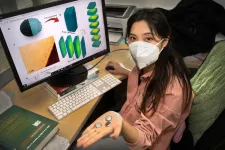Shoot better drone videos with a single word
Research from robotics Ph.D. maps emotions to robotic behavior
2021-06-03
(Press-News.org) The pros make it look easy, but making a movie with a drone can be anything but.
First, it takes skill to fly the often expensive pieces of equipment smoothly and without crashing. And once you've mastered flying, there are camera angles, panning speeds, trajectories and flight paths to plan.
With all the sensors and processing power onboard a drone and embedded in its camera, there must be a better way to capture the perfect shot.
"Sometimes you just want to tell the drone to make an exciting video," said Rogerio Bonatti, a Ph.D. candidate in Carnegie Mellon University's Robotics Institute.
Bonatti was part of a team from CMU, the University of Sao Paulo and Facebook AI Research that developed a model that enables a drone to shoot a video based on a desired emotion or viewer reaction. The drone uses camera angles, speeds and flight paths to generate a video that could be exciting, calm, enjoyable or nerve-wracking -- depending on what the filmmaker tells it.
The team presented their paper on the work at the 2021 International Conference on Robotics and Automation this month.
"We are learning how to map semantics, like a word or emotion, to the motion of the camera," Bonatti said.
But before "Lights! Camera! Action!" the researchers needed hundreds of videos and thousands of viewers to capture data on what makes a video evoke a certain emotion or feeling. Bonatti and the team collected a few hundred diverse videos. A few thousand viewers then watched 12 pairs of videos and gave them scores based on how the videos made them feel.
The researchers then used the data to train a model that directed the drone to mimic the cinematography corresponding to a particular emotion. If fast moving, tight shots created excitement, the drone would use those elements to make an exciting video when the user requested it. The drone could also create videos that were calm, revealing, interesting, nervous and enjoyable, among other emotions and their combinations, like an interesting and calm video.
"I was surprised that this worked," said Bonatti. "We were trying to learn something incredibly subjective, and I was surprised that we obtained good quality data."
The team tested their model by creating sample videos, like a chase scene or someone dribbling a soccer ball, and asked viewers for feedback on how the videos felt. Bonatti said that not only did the team create videos intended to be exciting or calming that actually felt that way, but they also achieved different degrees of those emotions.
The team's work aims to improve the interface between people and cameras, whether that be helping amateur filmmakers with drone cinematography or providing on-screen directions on a smartphone to capture the perfect shot.
"This opens this door to many other applications, even outside filming or photography," Bonatti said. "We designed a model that maps emotions to robot behavior."
INFORMATION:
[Attachments] See images for this press release:

ELSE PRESS RELEASES FROM THIS DATE:
2021-06-03
North Carolina State University researchers have developed a computer simulation tool to predict when and where pests and diseases will attack crops or forests, and also test when to apply pesticides or other management strategies to contain them.
"It's like having a bunch of different Earths to experiment on to test how something will work before spending the time, money and effort to do it," said the study's lead author Chris Jones, research scholar at North Carolina State University's Center for Geospatial Analytics.
In the journal Frontiers in Ecology and the Environment, researchers reported on their efforts to develop and test ...
2021-06-03
KINGSTON, R.I. - June 3, 2021 - Scientists from the University of Rhode Island have taken the first steps toward understanding the function of microbes that live on and in Eastern oysters, which may have implications for oyster health and the management of oyster reefs and aquaculture facilities.
"Marine invertebrates like oysters, corals and sponges have a very active microbiome that could potentially play a role in the function of the organism itself," said Ying Zhang, URI associate professor of cell and molecular biology. "We know very little about whether there are resident microbes in oysters, and if there are, what their function may be or how they may help or bring harm to the oyster."
Zhang and doctoral student Zachary Pimentel extracted the DNA of microbes living in ...
2021-06-03
ANN ARBOR, Mich. -- A different type of surge may be on the way more than a year into the pandemic - a baby surge.
The COVID-19 shutdown initially seemed to hit pause on pregnancy and birth rates, new research from one major hospital system suggests, but that trend is quickly reversing.
"Birth rates declined early on in the pandemic, but we expect a dramatic rebound soon," says lead author Molly Stout, M.D., MSci, maternal fetal medicine director at Michigan Medicine Von Voigtlander Women's Hospital.
"We're already seeing signs of a summer baby surge."
While infectious ...
2021-06-03
UPTON, NY--A team of researchers led by chemists at the U.S. Department of Energy's (DOE) Brookhaven National Laboratory has studied an elusive property in cathode materials, called a valence gradient, to understand its effect on battery performance. The findings, published in Nature Communications, demonstrated that the valence gradient can serve as a new approach for stabilizing the structure of high-nickel-content cathodes against degradation and safety issues.
High-nickel-content cathodes have captured the attention of scientists for their high capacity, a chemical property that could power electric vehicles over much longer distances than current batteries support. Unfortunately, the high nickel content also causes these cathode materials to degrade more quickly, creating cracks ...
2021-06-03
The South Pole and the rest of East Antarctica is cold now and was even more frigid during the most recent ice age around 20,000 years ago -- but not quite as cold as previously believed.
University of Washington glaciologists are co-authors on two papers that analyzed Antarctic ice cores to understand the continent's air temperatures during the most recent glacial period. The results help understand how the region behaves during a major climate transition.
In one paper, an international team of researchers, including three at the UW, analyzed seven ice cores from across West and East Antarctica. The results published June 3 in Science show warmer ice age temperatures in the eastern part of the continent.
The team ...
2021-06-03
Scientists have gained the best view yet of the brightest explosions in the universe: A specialised observatory in Namibia has recorded the most energetic radiation and longest gamma-ray afterglow of a so-called gamma-ray burst (GRB) to date. The observations with the High Energy Stereoscopic System (H.E.S.S.) challenge the established idea of how gamma-rays are produced in these colossal stellar explosions which are the birth cries of black holes, as the international team reports in the journal Science.
"Gamma-ray bursts are bright X-ray and gamma-ray flashes observed in the sky, emitted by distant extragalactic sources," explains DESY scientist Sylvia Zhu, one of the authors of the ...
2021-06-03
The biggest shark attack in history did not involve humans.
A new study by Earth scientists from Yale and the College of the Atlantic has turned up a massive die-off of sharks roughly 19 million years ago. It came at a period in history when there were more than 10 times more sharks patrolling the world's oceans than there are today.
For now, researchers don't know the cause of the shark die-off.
"We happened upon this extinction almost by accident," said Elizabeth Sibert, a Hutchinson postdoctoral associate in Yale's Department of Earth and Planetary Sciences and ...
2021-06-03
Scientists have developed the first cells that can construct artificial polymers from building blocks that are not found in nature, by following instructions the researchers encoded in their genes.
The study, led by scientists from the Medical Research Council (MRC) Laboratory of Molecular Biology, in Cambridge, UK, also found the synthetic genome made the bacteria entirely resistant to infection by viruses.
The scientists say their research could lead to the development of new polymers - large molecules made of many repeating units, such as proteins, plastics, and many drugs including antibiotics - and make it easier to ...
2021-06-03
Hydrogels are polymer materials made mostly from water. They can be used in a wide range of medical and other applications. However, previous incarnations of the materials suffered from repeated mechanical stress and would easily become deformed. A novel crystal that can reversibly form and deform, allows hydrogels to rapidly recover from mechanical stress. This opens up the use of such biocompatible materials in the field of artificial joints and ligaments.
Many of us suffer the occasional sports injury or experience some kind of pain relating to joints and ligaments at some point in our lives. ...
2021-06-03
Researchers from University of Toronto Engineering have developed an improved electrochemical system that raises the value of captured CO2 by converting more of it into valuable products than ever before.
The International Energy Agency recently cited carbon capture and storage as one of the strategies that can help keep global emissions low enough to limit global warming to 1.5 C by 2050. But captured carbon currently has little economic value, reducing the incentive for companies to invest in this technology.
A University of Toronto Engineering team led by Professor Ted Sargent is addressing this challenge by designing advanced electrolyzers that use electricity to convert captured CO2 into the petrochemical building blocks of common everyday materials, ...
LAST 30 PRESS RELEASES:
[Press-News.org] Shoot better drone videos with a single word
Research from robotics Ph.D. maps emotions to robotic behavior




